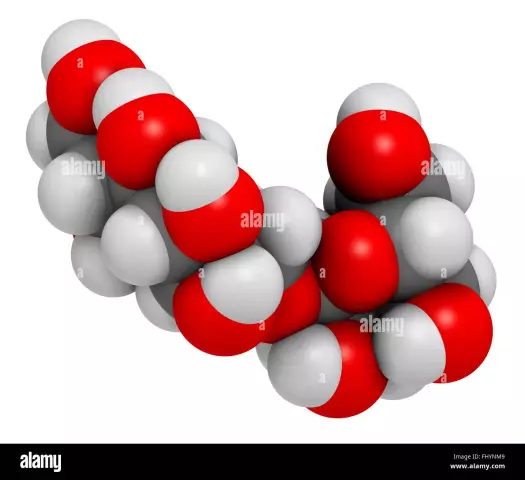- Author Rachel Wainwright [email protected].
- Public 2023-12-15 07:39.
- Last modified 2025-11-02 20:14.
Sugar
Sugar is a high-calorie food product. According to statistics, a person annually consumes about sixty kilograms of this carbohydrate.

India is considered the homeland of the product, where it has been known for about 2500 years. Brown grains were made from sugar cane and supplied to European countries from India. Egypt acted as an intermediary in this trade.
In Russia, it first appeared around the 11th century. At that time, only the king and his entourage could use this valuable product.
In 1802, the production of sugar from beets was established, first near Tula, and then in other regions of the country.
According to its composition and properties, sugar is divided into disaccharides, monosaccharides and polysaccharides.
Monosaccharides include fructose (fruit sugar), dextrose or glucose (grape sugar), and galactose. Disaccharides include maltose (malt sugar), lactose (milk sugar), and sucrose (cane and beet sugar). The human intestine only assimilates monosaccharides.
Various types of sugar are currently produced - palm, cane, beetroot, white and brown. All its types are released in a purified and unrefined form.
Refined (refined) sugar is steamed, converted into syrup and filtered, after which it turns into a beautiful white mass, which is evaporated and then dried.
Honey is a special kind of sugar. It contains about 20% water, trace elements and minerals and about 80% sugar in the form of sucrose, glucose and fructose.
The properties of brown sugar useful for the human body are explained by the content of molasses and a whole range of useful components in it. Although the caloric value of brown sugar is much higher than white.
There are the following types of sugar: bakery, fruit, regular, crystalline, ultrafine, coarse, liquid, confectionery powder and dusting sugar.
The best known among consumers are granulated sugar and refined sugar. Lump and lollipop sugar are considered less popular. Most often they are served in restaurants with various drinks.
Nutritional value and calorie content of sugar
One hundred grams of this sweet product contains 99.8 g of mono - and disaccharides, 0.1 g of ash, 0.1 g of water, 3 mg of calcium, 0.3 mg of iron, 3 mg of potassium and 1 mg of sodium.
The calorie content of sugar is 399 kcal per 100 g of product. Scientists believe that women can consume no more than four teaspoons of this product daily, men - no more than six spoons, and children - one teaspoon a day.
The beneficial properties of sugar
An important benefit of sugar lies in its ability to activate blood circulation in the spinal cord and brain. There is an opinion among scientists that sugar brings undoubted benefits in diseases of the spleen and liver, since glucose supports the barrier function of the liver, participating in the synthesis of glucuronic and paired sulfuric acids.
This product indirectly increases the release of serotonin in the brain - the "good mood hormone".
Sugar is considered one of the main sources of carbohydrates for the human body. The benefits of sugar include the fact that this sweet product saturates the human muscles with the necessary energy, eliminates headaches, and relieves fatigue for a short period of time.

Sugar harm
Speaking about the dangers of sugar, it should be remembered that this product can be internal and external.
The first is found in cereals, fruits, and some vegetables. Sugar of this type is not considered harmful, since it is retained in the human body in the amount necessary for normal life.
External sugar is found in molasses, cakes, candy, drinks, and other sweet foods. Eating large amounts of this type of sugar is harmful to the body.
Refined white sugar from beets or cane is free of fiber, vitamins, proteins and minerals. This product is 99% pure simple carbohydrate.
When sugar enters the body, it immediately enters the blood plasma. It is absorbed into the bloodstream so quickly that it requires an excessive concentration of insulin. A sharp jump in insulin levels leads to a decrease in the concentration of this carbohydrate in the blood, resulting in hypoglycemia. A similar condition manifests itself in increased fatigue, loss of energy, slowness of movement, dizziness, anemia, low blood pressure, darkening of the eyes, hair loss, cyanosis.
The greatest harm of sugar is that it removes calcium and other minerals from the body, absorbs valuable nutrients, and depletes protein reserves. All this leads to the development of caries, rickets, osteoporosis - painful destruction of bones.
A sharp rise and a sharp decline in the concentration of glucose in the blood causes a feeling of false hunger.
Adequate protein intake and excessive sugar intake lead to the development of obesity, and a lack of protein in the body and excessive sugar intake are very often the cause of thinness.
Excessive sugar consumption lowers the strength of the immune system seventeen times. Doctors in London have found that this sweet product is able to partially alter bacteria on the lining of the intestinal wall. This leads to the breakdown of bile salts and the formation of substances that cause cancer.
Cardiovascular disease is caused by a combination of animal sugars and fats that are deposited in the walls of arteries as cholesterol.
Excessive consumption of sugar-containing foods increases the risk of developing diabetes mellitus, diseases of the brain, blood, and also contributes to premature aging. The carbohydrate is deposited in the collagen of the skin, decreasing its elasticity.
Sugar consumption contributes to the formation of harmful free radicals that kill the human body from the inside out.
YouTube video related to the article:
Found a mistake in the text? Select it and press Ctrl + Enter.






